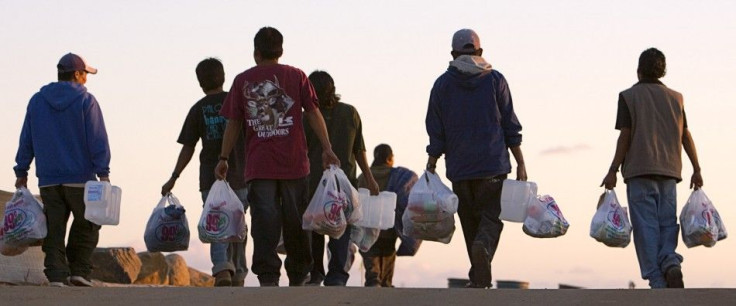More Mexicans Leave US Than Enter: Historic Decline In Immigration Since Depression

Mexican immigration to the U.S., considered the largest wave of immigration in history from a single country to the states, has dropped sharply and may have reversed due to the weak U.S. jobs market, stricter regulation on border crossing and rising deportations.
Net migration from Mexico to the U.S. has become zero, and perhaps even less, as a result of the sharp downward trend that began in 2005, according to the study, which comes amid renewed debate over U.S. immigration policy as the Supreme Court hears arguments this week on Arizona's tough immigration law.
About 6.1 million unauthorized Mexican immigrants were living in the U.S. last year, down from a peak of nearly 7 million in 2007, a new analysis by the Pew Hispanic Center based on multiple government data sets from both countries found. It was the biggest sustained drop in modern history, believed surpassed in scale only by losses in the Mexico-born U.S. population during the Great Depression, MSNBC reported.
The 42-page report cited several reasons for the trend, including the weakened U.S. job and housing construction markets, heightened border enforcement, a rise in deportations, the growing dangers associated with illegal border crossings, the long-term decline in Mexico's birth rates and broader economic conditions in Mexico.
The researchers said the Mexican immigration wave may resume as the U.S. economy recovers. In all, the legal and illegal Mexican-American population last year fell to 12 million, marking an end to an immigration boom traced back to the 1970s. The peak was 12.6 million in 2007.
The study noted that the sharp four-decade rise in Mexican immigration after 1970 -- especially that of unauthorized migrants -- was driven by a combination of factors. The U.S. and Mexico had formally agreed in 1942 to establish the Bracero temporary-worker program. Though the agreement expired in 1964, the demand in the U.S. for low-skilled labor remained strong. Major changes to the U.S. immigration law in 1965, however, favored immigrants who wanted to rejoin their families in the U.S., and not those who came solely to work. Economic troubles and other problems in Mexico also encouraged people to migrate to the north.
The U.S. is still home to a large Mexican-American population. Among Mexican-born people worldwide, 1-in-10 lives in the U.S. Currently immigrants born in Mexico account for some 30 percent of those coming to the U.S., with China -- including Hong Kong and Taiwan -- accounting for roughly 5 percent of the nation's current stock of about 40 million immigrants, the researchers said.
Other findings by the Pew Center study:
-- More than half of all Mexican immigrants are unauthorized, while 58 percent of the estimated 11.2 million unauthorized immigrants in the U.S. are Mexican. They tend to be younger, poorer, less educated and less fluent in English and less likely to be naturalized citizens, compared to other immigrants to the U.S.
-- Apprehensions of Mexicans trying to cross the border illegally have plummeted by more than 70 percent in recent years, from more than 1 million in 2005 to 286,000 in 2011 -- a likely indication that fewer unauthorized immigrants are trying to cross. This decline has occurred at a time when funding in the U.S. for border enforcement -- including more agents and more fencing -- has risen sharply.
-- Although most unauthorized Mexican immigrants sent home by U.S. authorities say they plan to try to return, a growing share say they won't try to come back to the U.S. According to a survey by Mexican authorities of repatriated immigrants, 20 percent of labor migrants in 2010 said they wouldn't return, compared with just 7 percent in 2005.
-- By region, Mexican-born immigrants in the U.S. are mostly likely found in the West (51 percent) and South (33 percent). About 58 percent now live in California and Texas, down from 63 percent in 2000 as immigrants spread out over the past decade in search of jobs in other states.
© Copyright IBTimes 2024. All rights reserved.





















